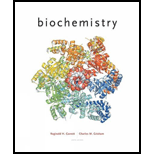
Concept explainers
(a)
Interpretation:
The equilibrium constant for the reaction should be calculated.
Concept Introduction:
A
(a)
Answer to Problem 1P
The equilibrium constant for the reaction is 360,333
Explanation of Solution
The equilibrium constant can be calculated as follows:
(b)
Interpretation:
The factor that must exceed in the reaction to proceed in the reverse direction should be explained.
Concept Introduction:
For the reverse reaction, the expression for
(b)
Answer to Problem 1P
The reaction will proceed in the reverse direction when G > 0. The natural log term must be >1.
Explanation of Solution
The reaction will proceed in the reverse direction when G > 0. The natural log term must be >1.
We already know that [ATP] = [ADP]. By using this reaction and the value obtained in part a gives:
(c)
Interpretation:
The value of Keqshould be explained.
Concept Introduction:
The same magnitude relation of merchandise and reactants are going to be reached. Keq is independent of pressure. Basically, changes in pressure are like changes in concentration for gases. Keq can rely upon the relative energies of reactants and merchandise.
(c)
Answer to Problem 1P
The value of Keq=
Explanation of Solution
With the help of the formula described in part a, Keqcan be calculated.
(d)
Interpretation:
The ratio of [PEP] / [pyruvate] should be explained.
Concept Introduction:
For the reaction, the expression for the equilibrium constant is as follows:
(d)
Answer to Problem 1P
The ratio of [PEP] / [pyruvate] is equal to 724
Explanation of Solution
Told that [ATP] = [ADP], [GTP] = [GDP], and [Pi] = 1 1 mM, we can figure out the ratio of [PEP] to [pyruvate].
(e)
Interpretation:
The reason for the substrate cycle to be strongly favored in both directions under physiological conditions should be explained.
Concept Introduction:
The same magnitude relation of merchandise and reactants are going to be reached. Keq is independent of pressure. Basically, changes in pressure are like changes in concentration for gases. Keq can rely upon the relative energies of reactants and merchandise.
For the reaction, the expression for the equilibrium constant is as follows:
(e)
Answer to Problem 1P
The reaction will be favorable in both directions under the following conditions:
Explanation of Solution
With the help of the observation from part b and part d of this question, the reaction will be favorable in both directions under the following conditions.
Want to see more full solutions like this?
- please draw it for me and tell me where i need to modify the structurearrow_forwardPlease help determine the standard curve for my Kinase Activity in Excel Spreadsheet. Link: https://mnscu-my.sharepoint.com/personal/vi2163ss_go_minnstate_edu/_layouts/15/Doc.aspx?sourcedoc=%7B958f5aee-aabd-45d7-9f7e-380002892ee0%7D&action=default&slrid=9b178ea1-b025-8000-6e3f-1cbfb0aaef90&originalPath=aHR0cHM6Ly9tbnNjdS1teS5zaGFyZXBvaW50LmNvbS86eDovZy9wZXJzb25hbC92aTIxNjNzc19nb19taW5uc3RhdGVfZWR1L0VlNWFqNVc5cXRkRm4zNDRBQUtKTHVBQldtcEtWSUdNVmtJMkoxQzl3dmtPVlE_cnRpbWU9eEE2X291ZHIzVWc&CID=e2126631-9922-4cc5-b5d3-54c7007a756f&_SRM=0:G:93 Determine the amount of VRK1 is present 1. Average the data and calculate the mean absorbance for each concentration/dilution (Please over look for Corrections) 2. Blank Correction à Subtract 0 ug/mL blank absorbance from all readings (Please over look for Corrections) 3. Plot the Standard Curve (Please over look for Corrections) 4. Convert VRK1 concentration from ug/mL to g/L 5. Use the molar mass of VRK1 to convert to M and uM…arrow_forwardMacmillan Learning Cholesterol synthesis begins with the formation of mevalonate from acetyl CoA. This process activates mevalonate and converts it to isopentenyl pyrophosphate. Identify the atoms in mevalonate and isopentenyl pyrophosphate that will be labeled from acetyl CoA labeled with 14C in the carbonyl carbon. Place 14C atoms and C atoms to denote which carbon atoms are labeled and which are not labeled. H₂C COA 14C-labeled acetyl-CoA HHH [c] H H OH 014C - OH H HH H Mevalonate CH3 H H 14C H Η H H Incorrect Answer of o -P-O-P-0- Isopentenyl pyrophosphate с Answer Bank 14Carrow_forward
- Draw the reaction between sphingosine and arachidonic acid. Draw out the full structures.arrow_forwardDraw both cis and trans oleic acid. Explain why cis-oleic acid has a melting point of 13.4°C and trans-oleic acid has a melting point of 44.5°C.arrow_forwardDraw the full structure of the mixed triacylglycerol formed by the reaction of glycerol and the fatty acids arachidic, lauric and trans-palmitoleic. Draw the line structure.arrow_forward
- Draw out the structure for lycopene and label each isoprene unit. "Where is lycopene found in nature and what health benefits does it provide?arrow_forwardWhat does it mean to be an essential fatty acid? What are the essential fatty acids?arrow_forwardCompare and contrast primary and secondary active transport mechanisms in terms of energy utilisation and efficiency. Provide examples of each and discuss their physiological significance in maintaining ionic balance and nutrient uptake. Rubric Understanding the key concepts (clearly and accurately explains primary and secondary active transport mechanisms, showing a deep understanding of their roles) Energy utilisation analysis ( thoroughly compares energy utilisation in primary and secondary transport with specific and relevant examples Efficiency discussion Use of examples (provides relevant and accurate examples (e.g sodium potassium pump, SGLT1) with clear links to physiological significance. Clarity and structure (presents ideas logically and cohesively with clear organisation and smooth transition between sections)arrow_forward
- 9. Which one of the compounds below is the major organic product obtained from the following reaction sequence, starting with ethyl acetoacetate? 요요. 1. NaOCH2CH3 CH3CH2OH 1. NaOH, H₂O 2. H3O+ 3. A OCH2CH3 2. ethyl acetoacetate ii A 3. H3O+ OH B C D Earrow_forward7. Only one of the following ketones cannot be made via an acetoacetic ester synthesis. Which one is it? Ph کہ A B C D Earrow_forward2. Which one is the major organic product obtained from the following reaction sequence? HO A OH 1. NaOEt, EtOH 1. LiAlH4 EtO OEt 2. H3O+ 2. H3O+ OH B OH OH C -OH HO -OH OH D E .CO₂Etarrow_forward
 BiochemistryBiochemistryISBN:9781305577206Author:Reginald H. Garrett, Charles M. GrishamPublisher:Cengage Learning
BiochemistryBiochemistryISBN:9781305577206Author:Reginald H. Garrett, Charles M. GrishamPublisher:Cengage Learning
